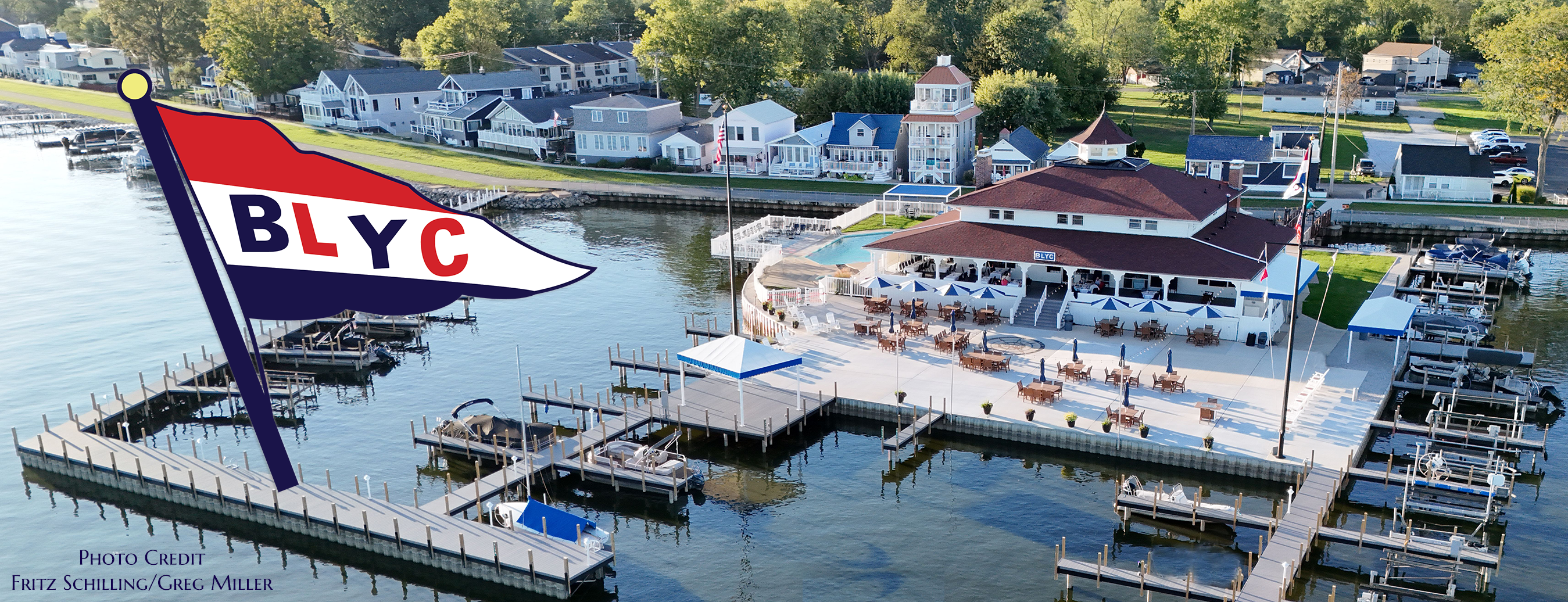Often, we focus our rules discussions only on Part 2 of the rules – “When Boats Meet.” This winter, I plan to explore the rules of Part 3 – “Conduct of a Race.” They may appear to only matter to the Race Committee, but they have significant importance to the racing sailor too.
– Steve Harris, US Sailing National Race Officer
Rule 33 - Changing the Next Leg of the Course
“While boats are racing, the race committee may change a leg of the course that begins at a rounding mark or at a gate by changing the position of the next mark (or the finishing line) and signalling all boats before they begin the leg. The next mark need not be in position at that time.
If the direction of the leg will be changed, the signal shall be the display of flag C with repetitive sounds and one or both of
the new compass bearing or
a green triangle for a change to starboard or a red rectangle for a change to port.
If the length of the leg will be changed, the signal shall be the display of flag C with repetitive sounds and a ‘–’ if the length will be decreased or a ‘+’ if it will be increased.
Subsequent legs may be changed without further signalling to maintain the course shape.”
Although a bit lengthy, this rule is actually pretty straightforward. To ensure that we’re all using the same language, recall the post on RRS 32 about Shortening the Course…
Shortening the course is the elimination of legs of the course. This is part of RRS 32.
What this rule (RRS 33) speaks to is Changing the course. This sometimes creates confusion, as we discussed in Post #7. But, if you remember “C is for Change,” you’ll be fine with this rule.
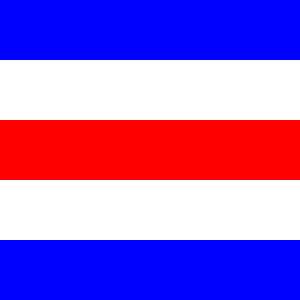
Keep in mind, the racing rules are written in such a way as to give the race committee tools that allow them to save a race. Lots of things happen on a race course that have the potential to make it less than ideal…
- Wind shifts make the course less than fair
- Changes in wind velocity make it desirable to change the length of the course.
- Changes in wind velocity make it unlikely that any boat will finish within the time limit.
- Impending safety concerns (foul weather, heavy seas, etc.) make it desirable to shorten the overall time the boats are going to be on the water
- etc.
Rule 33 makes it possible for the race committee to adjust to these changes and keep the racing fair, safe, and competitive.
Let’s look first at changing the direction to the next mark…
In the case of a wind shift, the course becomes less square and inherently less fair. Often, you’ll hear the argument “We’ve all got to sail in the same wind” as a reason not to move a mark and change it’s location. The problem is, not all boats in the fleet are truly in the same wind when the course isn’t square! Depending where you are on the course when the shift happens, some boats will be benefitted by a lift and others will be hampered by a header… and perhaps significantly so. Additionally, the tactically sailable area is also significantly reduced.
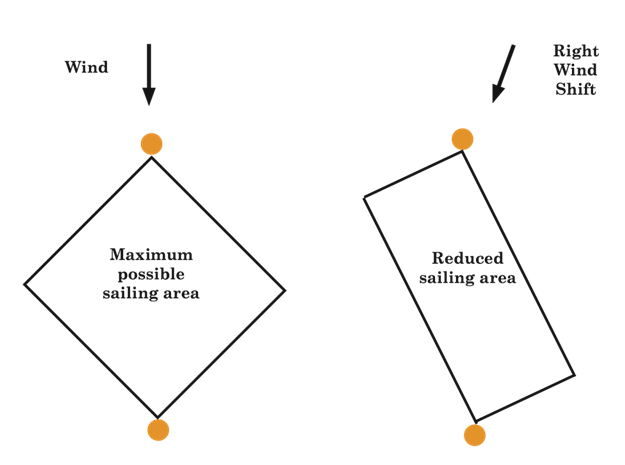
In order to maintain the best tacking angle upwind, the area in which boats can tactically sail in is significantly reduced.
Assuming an upwind tacking angle of 90°…
SHIFT
0°
5°
10°
20°
30°
45°
TIME ON
FAVORED TACK
50%
54%
59%
68%
79%
100%
EFFECTIVE
SAILING AREA
100%
98%
94%
77%
50%
0%
It gets even worse downwind…
Assuming a downwind gybing angle of 50°…
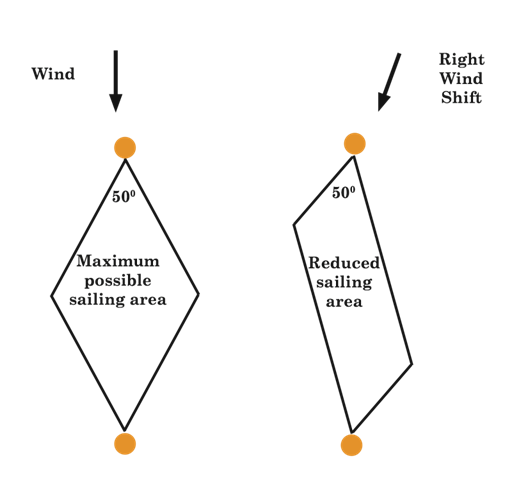
SHIFT
0°
5°
10°
15°
20°
25°
TIME ON
FAVORED TACK
50%
59%
69%
79%
89%
100%
EFFECTIVE
SAILING AREA
100%
96%
83%
62%
35%
0%
The effective sailing area reduces much quicker with less of a shift!
If the race committee doesn’t change the course, it’s hard to call it a fair, tactical, and competitive race. Changes are critical to making races competitive!
The difficulty for the race committee is knowing when to make a change. It’s easy to get drawn into trying too hard to make it “perfect,” and changing when a shift is just an oscillation. But its important to change when necessary. Now you know why sometimes race officers are so uptight & tense! LOL
So… how is a change signaled?
“…
If the direction of the leg will be changed, the signal shall be the display of flag C with repetitive sounds and one or both of
the new compass bearing or
a green triangle for a change to starboard or a red rectangle for a change to port.“
The important part to be able to recognize is the display of the flag, C, with repetitive sounds. Direction of the change is likely apparent, however the race committee is required to signal it.
Generally, the change will be signaled by a mark boat, near the mark previous to the one being changed. Unlike the shorten course signal (RRS 32), a change must be signaled before any boat sails the new leg of the course.
The race committee has two options:
- They can display the compass bearing to the new mark:
- They can signal a change to starboard (right as one looks towards the next mark) with a green triangle…
The race committee can also change the length of the next leg…
“…
So the race committee can change both the direction and the distance of the next leg of the course. Pay close attention to the signals being made. This affords them a great deal of flexibility in maintaining a competitive race course for the sailors.
Let’s look at one of our courses at BLYC…

This course, Course “E,” is a typical triangle-windward-leeward course –
S – 1 – 2 – 3 – 1 – 3 – F
Assume a significant windshift to the left makes it desirable to change the position of Mark 1 on the second windward leg.
The race committee will signal the change at mark 3 (before any boat begins the leg). They will hoist Code Flag “Charlie” with repetitive sounds and a red rectangle.
NOTE: The new mark need not be in the water yet. The signal tells you that a change is being made. By the rules, the mark doesn’t need to be there until boats are there to round it. Ideally, the race committee gets it into position well before any boat is approaching, but the rules give them a lot of leeway in making the change. Remember – the purpose is to “save” the race and keep it competitive.
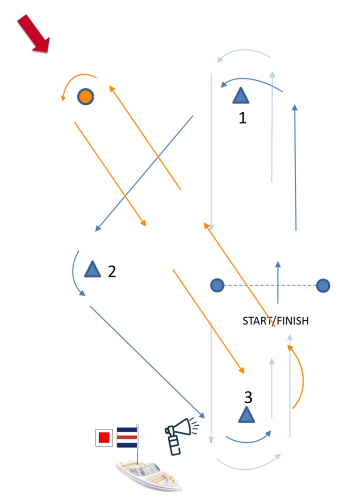
You would now sail to the “new” mark – ideally it is of a different color and/or shape (this would be described in the SIs), although that is not always the case.
Notice that, to maintain the same course angles, the race committee should also move Mark 3 and change the angle of the finish line. Sometimes with short course racing, this isn’t always practical if the fleet is spread out, but, ideally, that would be the proper thing to do.

Notice, however, that this subsequent “change” is not signaled…
“…
c. Subsequent legs may be changed without further signalling to maintain the course shape.”
Once the first change is signaled, subsequent changes do not have to be signaled. In other words, you should assume that subsequent legs are likely to be changed. The race committee is free to do so without tying up valuable resources signaling at each mark.
If a separate “change mark” is being used for the primary change, it is entirely possible that subsequent “changes” will not utilize these change marks. More than likely, the existing marks will be relocated to their adjusted positions if possible. “Change Marks” are not addressed specifically in the rules and there is not one standard practice used in this situation.
How much of a shift will initiate a change?
It depends…
Ok, not the best answer, but an accurate one. In some venues, the wind blows steady and at pretty much the same velocity and direction at the same time every day. Buckeye Lake is NOT one of those venues! In those places, particularly for “high level” events, a change of 10-15 degrees might be enough for the race committee to change the angle of the next leg. In places that are known for more shifty winds (like most of our region), that threshold is typically higher.
Knowing when to make a change is, very often, more of an art than it is a science. A good Race Officer knows the venue and has a good “feel” for local conditions (or, if visiting, has someone on board the RC boat who does.) One thing that seems to be a truism in race management is that any change will be greeted with both support and criticism. That’s the nature of things and perfectly understandable. Just as with most things rules-related though, I always remember George Fisher’s admonishment regarding the rules… “Don’t let one incident ruin your whole race.” The race committee may signal a change you think was unnecessary (maybe you were on the “lifted” side of the course and had gained an advantage.) Trust that they made the change for good reason, sail the course and keep sailing your race. Once signaled, right or wrong, that is the course you have to sail according to the rules.
Is it ever required for the race committee to change course?
Typically no…
Generall speaking, the rules of Part 3 are permissive rather than proscriptive. That is they allow the race committee options but, generally, they seldom require them to exercise those options. In the case of this rule, the decision is that of the race committee – “…may change a leg of the course…” The procedures to do so, however, are proscriptive – “… the signal shall be…”
Sometimes Sailing Instructions or Class Rules might give specific directions on changing course. Although, in my experience, I’ve found that, more often than not, they restrict the ability to change and proscribe abandonment instead. (rather than direct the RC when to make a change)
